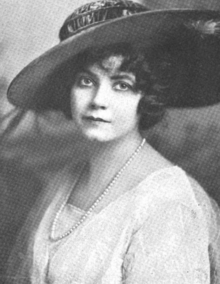Camille Astor
Camille Astor (born before 1900 – died September 16, 1944) was an American actress in silent films.
Early life[edit]
Astor usually said to have been born in 1896 in Warsaw, then a part of the Russian Empire. During 1910 court testimony, she gave a different story, saying that she was born in Manchester, England as "Grace Curry", sometime before 1890, though this may also have been an embellished account.[1] She trained as a dancer and was a proficient swimmer as well.[2][3]
Career[edit]
Astor was a dancer and actress in Los Angeles from at least 1910.[1] Films featuring Astor included Chimmie Fadden and Chimmie Fadden Out West (both 1915, directed by Cecil B. DeMille),[4][5] The Thousand-Dollar Husband (1916, starring Blanche Sweet), For the Defense (1916, directed by Frank Reicher),[6] To Have and to Hold (1916, directed by George Melford),[7] The Garden of Allah (1916, starring Helen Ware), and For Those We Love (1921, directed by Arthur Rosson). She earned an assistant director's credit on The Sowers (1916), working with William C. deMille and Frank Reicher.[8] She was adept at languages, and helped with interpreting on some film sets.[9] In 1915 she offered her services as a "Polish Red Cross nurse" and danced at war relief benefit events in Los Angeles.[10][11][12][13]
Personal life[edit]
Astor was named co-respondent in the first divorce of real estate broker DeKalb Spurlin in 1910,[1][14] and married him as his second wife in 1915.[15][16] Based on claims of infidelity and cruelty,[17] they divorced in 1919,[18][19][20] but she was threatened by a judge with jail time when she continued to harass her ex-husband in 1920.[21] She married again in 1922, to engineer Jack Moore.[22] She died in Los Angeles in 1944, in her fifties.[citation needed]
References[edit]
- ^ a b c "Fighting for a Reputation; Dancing Girl Denies Charge Made by Wife". The Los Angeles Times. 1910-02-04. p. 17. Retrieved 2022-04-14 – via Newspapers.com.
- ^ "Camille Astor". Photoplay. 10. October 1916.
- ^ "When She Swims". Photoplay. 10 (July 1916): 105. via Internet Archive
- ^ Higashi, Sumiko (1994-12-02). Cecil B. DeMille and American Culture: The Silent Era. University of California Press. p. 206. ISBN 978-0-520-91481-0.
- ^ "Victor Moore at Lyric in 'Chimmie Fadden'". The Evening Mail. 1915-08-02. p. 3. Retrieved 2022-04-14 – via Newspapers.com.
- ^ "'For the Defense'--Fannie Ward Mon-Tues in New Play at Queen". The Journal and Tribune. 1916-03-26. p. 32. Retrieved 2022-04-14 – via Newspapers.com.
- ^ Fleming, E. J. (2013-10-25). Wallace Reid: The Life and Death of a Hollywood Idol. McFarland. pp. 88, 250. ISBN 978-0-7864-7725-8.
- ^ Slide, Anthony (2022-03-15). The Silent Feminists: America's First Women Directors. Rowman & Littlefield. p. 127. ISBN 978-1-5381-6553-9.
- ^ "She is Interpreter at Big Film Studio". Knoxville Sentinel. 1916-05-22. p. 10. Retrieved 2022-04-14 – via Newspapers.com.
- ^ "Polish Kiddies Dance for Their Fatherland". Los Angeles Herald. March 23, 1915. p. 1. Retrieved April 14, 2022 – via California Digital Newspaper Collection.
- ^ "L. A. Girl Offers Services as Polish Red Cross Nurse". Los Angeles Herald. March 9, 1915. p. 1. Retrieved April 14, 2022 – via California Digital Newspaper Collection.
- ^ "Benefit Concert for Polish War Relief". Los Angeles Herald. June 21, 1915. Retrieved April 14, 2022 – via California Digital Newspaper Collection.
- ^ "Form Committee for Poles' Relief". Los Angeles Herald. August 2, 1917. p. 3. Retrieved April 14, 2022 – via California Digital Newspaper Archive.
- ^ "Wealthy Realty Man Seeks Third Divorce". Los Angeles Evening Post-Record. 1923-01-27. p. 2. Retrieved 2022-04-14 – via Newspapers.com.
- ^ "Romance Revealed as Actress and L. A. Man are to Wed". Los Angeles Herald. August 30, 1915. p. 1. Retrieved April 14, 2022 – via California Digital Newspaper Collection.
- ^ "'Married Woman Can Follow a Profession and Be Good Wife'". Evansville Press. 1915-09-25. p. 1. Retrieved 2022-04-14 – via Newspapers.com.
- ^ "Spurlin Admits Visits but not Love or Kisses; Wife's Charges in Divorce Suit are Denied". Los Angeles Evening Express. 1919-02-25. p. 3. Retrieved 2022-04-14 – via Newspapers.com.
- ^ "Spurlins Refused Decree of Divorce". Los Angeles Evening Post-Record. 1919-02-27. p. 6. Retrieved 2022-04-14 – via Newspapers.com.
- ^ "Saw Hugging, Kissing Scene from Window, Mrs. Shuebrook Says". Los Angeles Evening Express. 1919-02-22. p. 9. Retrieved 2022-04-14 – via Newspapers.com.
- ^ "Actress Wife Must Not Trail Husband". Santa Ana Register. 1919-07-22. p. 9. Retrieved 2022-04-14 – via Newspapers.com.
- ^ "Lawyer's Sentence for Client Adopted". The Los Angeles Times. 1920-01-13. p. 26. Retrieved 2022-04-14 – via Newspapers.com.
- ^ "Passing Through". Wisconsin State Journal. 1922-07-13. p. 4. Retrieved 2022-04-14 – via Newspapers.com.

